Gas burners for a can: types and principles of operation + nuances of selection and use
Some technologies for construction, pipeline installation, and car repair involve the use of a directed open flame. Gas burners on a can are popular in everyday life - small devices that allow you to regulate the direction, strength and temperature of the fire.
Models differ in purpose, design, and type of fuel, so before purchasing you need to take into account the basic criteria and purchase a device that is not only convenient, but also economical.
To make the task of choosing easier, we have prepared a detailed classification of portable burners, provided practical recommendations for determining the best model, and also outlined the rules for the safe operation of gas devices.
The content of the article:
Types of portable burners
Gas burners are devices that differ in design and purpose, but they are united by a common feature - they operate using gas.
Portable devices designed to operate from a small tube filled with propane-butane or other gas should not be confused with ovens or powerful welding units that operate from natural gas or a large cylinder.
We offer a brief overview of the main design elements of an inexpensive gas cartridge burner, which serves as an excellent example of a home device. It may be useful for repairs in the country or for a barbecue.
Using a compact device, you can quickly light a barbecue, heat bolts or nuts in the cold, melt plastic parts, and process heat shrinks. The flame temperature (up to +1300°C) is enough for soldering metal pipes.
This is an example of a burner type that is popular among users, but the range of devices is much wider. Let's look at the most popular types.
Difference by area of use
An open flame may be required at home, on vacation, and during installation work. One of the areas of application is tourism. In camping conditions, using a simple device, they light a fire and heat up canned food.
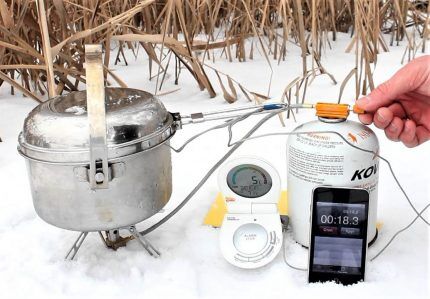
Burners with a directional torch of the “pistol” type are often used in installation work when soldering copper pipes, for bending plastic elements.

High-temperature high-power lamps can also process steel parts, but this requires hard solder and a slightly modified soldering technique.
Gas portable burners are also used for the following work:
- processing of wooden parts;
- lighting a barbecue or a fire in the country without the use of chemicals;
- calcination and cutting of metal blanks;
- singeing animal carcasses during butchering;
- thawing frozen pipelines.
This useful device is always at hand for craftsmen who love to improve their homes and improve their garden plots on their own. The burner can be useful in a car repair shop, during the construction of a greenhouse or other structures.
Division according to the method of attaching the can
The fuel cartridge is a consumable item.As soon as the fuel runs out, it is disconnected from the burner, and a new cartridge is installed in its place.
There are several ways to attach a cartridge to a device:
- threaded – fixed with a thread, in other words – screwed on;
- collet – put on and turn slightly to one side;
- valve – secured with a clamp;
- pierced – connect with light pressure.
Threaded models are more common than others. They form a strong connection between two elements that can be separated at any time. Punctureable ones, on the contrary, cannot be turned off until the gas in the can runs out.
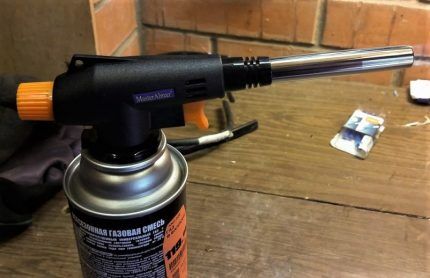
The weakness of collet devices is the rapid loosening of the clamp, resulting in loss of gas.
Valve burners, which are usually designed for heating food, are considered more reliable.
Differences in gas burners by fuel type
Manufacturers use various fuels to fill consumable cartridges. The choice of liquefied gas is based on the purpose of the burners, the required flame temperature, and power. To improve the characteristics of the composition, several different types of fuel are sometimes mixed.
The following combinations of substances are used most often:
- mixture of propane and butane (70:30) – mainly for summer use, but with a heating device it can also be used in winter;
- combination of propane, butane and isobutane in various proportions;
- MAPP mixture – methylacetylene-propadiene-propane, most often used for welding at temperatures of 1600-2500°C.
But there are cans filled with one gas, for example, butane.

The choice of fuel is important when work is to be done in harsh conditions - in the cold or at high altitudes. And in the summer, any universal gas is suitable for lighting a barbecue or fire.
Design features and operating principle
Burners vary in design - from basic devices with a nozzle to more complex mechanisms equipped with an air supply device and piezo ignition.
Let's consider the design of a torch designed for welding metal.
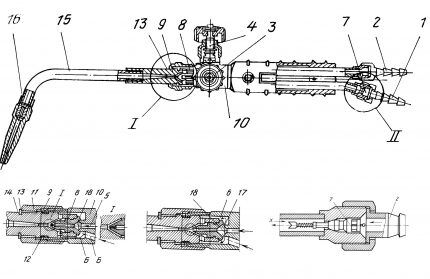
The design with an injector and check valve increases work productivity and reduces fuel consumption.
Almost all portable household appliances belong to the so-called injection burners, when air is naturally sucked into the burner to support the flame.
Inside, in a special chamber, fuel is mixed with air, as a result of which the fuel ignites after a spark is given.
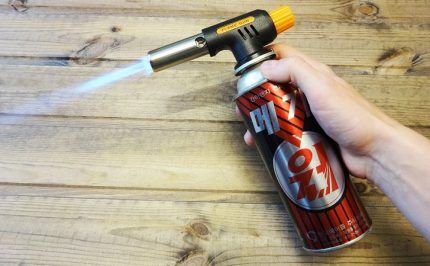
From the mixing chamber, the mixture of gases enters the nozzle-nozzle, where it is distributed through the channels. At the end of the structure, at the point where the torch is formed, there are fire holes - the ends of the channels.
Options for nozzles by structure: ring, slot, tubular.
Tips for choosing the optimal burner
Compact hand torches they buy with pleasure, as they have a lot of advantages over liquid-fuel, more “serious” devices. They light quickly, hardly get dirty, and require a minimum of care.
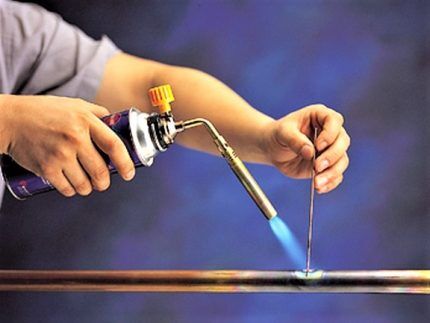
Criterion #1 - scope of use of the device
First of all, you should determine exactly what the gas appliance will be used for, since soldering torches and for heating food, they differ radically in both design and parameters.
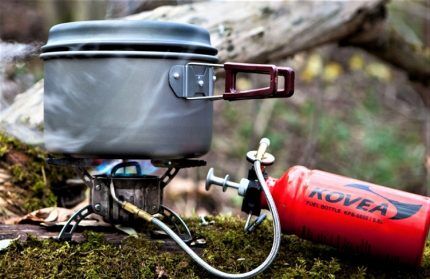
Construction tools often resemble a gun in shape. When working, it is convenient to hold them with one hand, and with the other at this time you can support the part or bring solder.
Criterion #2 - technical characteristics of the model
Characteristics such as weight and size are important if the burner has to be taken on hikes or often used at home. A heavy tool causes rapid fatigue, while a light one is much more comfortable to work with.
We pay attention to such characteristics as:
- flame temperature – from 480 to 2500°C;
- heating temperature – from 550 to 2500°C;
- power – 0.5-3 kW;
- the ability to connect cans with different fuels;
- method of connecting the cartridge to the burner;
- flame type, torch shape;
- fuel consumption – from 60 to 1000 g/h;
- weight – from 50 grams to 1.7 kg.
If you are purchasing a torch specifically for soldering copper pipes, then a low-temperature model will do.
To cut or weld steel parts, you will need a more powerful machine, usually called a torch or welding torch.
Overview of additional useful options:
It is not surprising that portable devices are popular, but when purchasing, it is necessary to take into account all the nuances, including technical characteristics, design features, efficiency, and ease of use.
Rules for safe operation
Working with flammable materials and open flames is always associated with risk, so when using even a simple hand-held device, you must follow safety rules.
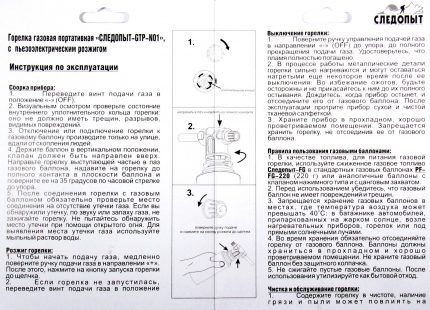
Overheating of the cylinder, which can be caused by the proximity of a heat source, for example, a fire or stove, is unacceptable. The canister may explode and cause injury due to the sharp edges of the torn casing. It is also not recommended to leave it in the sun.
Professional devices that are usually used for a long time require special care. Suppose, in order to preserve the functions of the burner and the power of the torch, after prolonged operation the device is packaged in a catalytic heating pad.
An overview of the best gas-air burners, as well as additional recommendations for choosing a suitable device, are presented in this article.
Conclusions and useful video on the topic
Review of a pistol-type torch, comparison with a blowtorch:
Analysis of the features of various models:
Testing inexpensive burners from an online store:
At home and on vacation, a burner is indispensable when there is a need to set something on fire, heat it up, or solder it. It solves problems in the cold season and helps out if it is necessary to quickly carry out repair work on a pipeline.
However, like other tools, the burner requires careful handling and compliance with operating rules.
Are you looking for a portable gas burner to solve household problems? Or do you have experience using such devices? Please leave comments on the article, ask questions and participate in discussions. The contact form is located below.




A gas burner is generally a very useful thing; it must be in a set of equipment and tools in the garage. Very useful for trips to nature. The main thing is not to save too much, just buy a normal burner that will cope with all tasks: like starting a fire or heating food, as well as for minor repairs and other household purposes. It’s better to immediately take it with piezo ignition.
I often go fishing, where wood is tight, so we heat food with a gas burner. So - for hiking in the forest, fishing and tourists, it is better to take a valve burner, simple and reliable, there have never been any problems with it. And don’t forget about safety! The compactness of the torch sometimes weakens self-control, which can lead to injury. Once they left a gas canister near the fire, it exploded so loudly that we almost shit ourselves =D
On the other hand, Slava, if the blowtorch had been left like that (which the burner replaces), it could have been much worse.